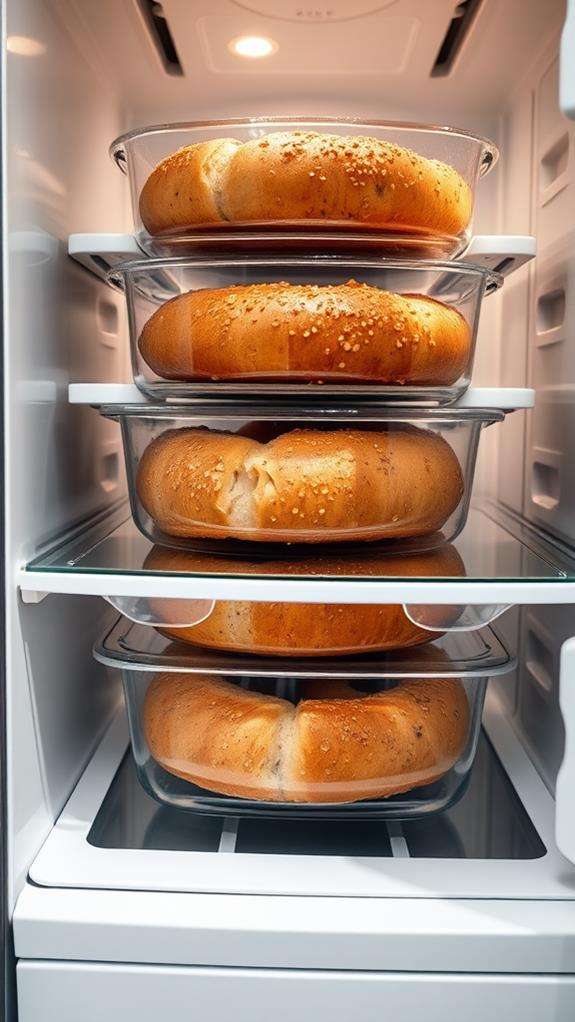How Long Do Bagels Last in the Fridge
In the refrigerator, bagels typically last 5-7 days when properly stored in an airtight container or freezer-grade plastic bag with excess air removed. You'll want to keep them at a temperature between 34-40°F and away from strong-smelling foods. While refrigeration extends their shelf life beyond the 2-3 days you'd get at room temperature, you'll notice the texture becoming firmer over time. Watch for signs of spoilage like mold spots, unusual odors, or slimy surfaces. For the best results, place sliced bagels with wax paper between them to prevent sticking. Learning proper storage and reheating techniques can help you enjoy fresh-tasting bagels longer.
This post may contain affiliate links. If you make a purchase through these links, I may earn a commission at no additional cost to you. Additionally, portions of this post may be generated using artificial intelligence (AI) technology. While we strive for accuracy, please be aware that AI-generated content may not always be perfect and should be fact-checked when necessary.
The Spatula Scoops
- Properly stored bagels last 5-7 days in the refrigerator when sealed tightly in plastic bags with excess air removed.
- Double-bagging and maintaining temperature between 34-40°F helps prevent moisture absorption and extends freshness.
- Place wax paper between sliced bagels to prevent sticking and ensure proper storage in the refrigerator.
- Check for signs of spoilage like mold, unusual odors, or slimy texture before consuming refrigerated bagels.
- Refrigerated bagels should be brought to room temperature and reheated in oven or toaster for best taste results.
Understanding Bagel Storage Basics

Storing bagels properly can make the difference between enjoying a fresh-tasting breakfast and biting into a stale, unappetizing disappointment. You'll need to understand the basic principles of bagel storage to maximize their shelf life and maintain their signature chewy texture.
At room temperature, fresh bagels typically stay good for 1-2 days when stored in a paper bag or bread box. You'll notice they begin losing their ideal texture after just 24 hours, which is why proper storage methods are essential. If you're planning to keep them longer, you'll want to evaluate either refrigeration or freezing.
The storage container you choose plays a significant role in preserving your bagels' freshness. While plastic bags might seem convenient, they can trap moisture and lead to mold growth. Instead, you'll want to opt for breathable containers or paper bags that allow proper air circulation. For longer storage, you can use freezer-safe bags or airtight containers, but you'll need to remove as much air as possible to prevent freezer burn. Understanding these fundamentals will help you make informed decisions about how to store your bagels based on when you plan to eat them.
Shelf Life at Room Temperature

Fresh bagels reach their peak flavor and texture when enjoyed within the first few hours after baking. When stored properly at room temperature (around 68-72°F), you'll find that your bagels typically remain fresh for 2-3 days, though their quality gradually declines after the first 24 hours.
To maximize your bagels' shelf life at room temperature, you'll want to store them in a paper bag or wrapped in a clean kitchen towel. This method allows the bagels to breathe while preventing excess moisture buildup that could lead to premature molding. If you're planning to keep them for more than a day, you can place them in a sealed plastic bag, but be aware that this may cause the crust to soften.
You'll know your room-temperature bagels have passed their prime when they become noticeably harder, develop a stale taste, or show visible signs of mold. While slightly stale bagels can be revived through toasting, any bagels showing mold should be discarded immediately. For ideal freshness, you shouldn't leave bagels sitting out uncovered on your counter, as they'll quickly become dry and unpalatable.
Proper Refrigeration Methods

For ideal freshness in the refrigerator, bagels should be sealed tightly in a plastic bag with as much air removed as possible. You'll want to use freezer-grade plastic bags rather than standard sandwich bags, as they provide superior moisture and odor protection. Before sealing the bag, press out excess air to create a vacuum-like seal that prevents freezer burn and moisture absorption.
If you've sliced your bagels before refrigeration, place a small piece of wax paper between each half to prevent them from sticking together. You'll also want to verify your refrigerator's temperature is set between 34-40°F (1-4°C) for prime preservation. Place the bagels in the main compartment rather than the door, where temperature fluctuations occur more frequently.
Don't store your bagels near strong-smelling foods, as they can absorb odors through their porous surface. If you're planning to keep them for more than two days, consider double-bagging them for extra protection. Remember to check the bags regularly for any condensation buildup, which could lead to mold growth. If you notice moisture, transfer the bagels to a fresh, dry bag immediately.
Signs of Bagel Spoilage

Even with proper storage methods, you'll need to watch for telltale signs that your bagels are past their prime. The most obvious indicator is visible mold, which can appear as green, blue, or white spots on the surface. If you notice any discoloration or fuzzy patches, it's time to discard the bagel immediately.
You should also pay attention to unusual odors, as bagels that have gone bad often develop a musty or sour smell that's distinctly different from their normal yeasty aroma. The texture can be another reliable indicator – if your bagel feels unusually hard, slimy, or has developed moisture on its surface, it's likely spoiled.
When examining refrigerated bagels, check for signs of freezer burn, which appears as white, dried-out patches on the surface. You'll want to feel the bagel's firmness too; while refrigerated bagels naturally become firmer, they shouldn't be rock-hard or crumbling. If you notice any off-putting changes in taste, even if other signs aren't present, trust your instincts and dispose of the bagel. Remember that consuming spoiled bread products can lead to foodborne illness, so it's better to err on the side of caution.
Reheating Refrigerated Bagels

Bringing refrigerated bagels back to their original texture requires proper reheating techniques. You'll want to let your bagel come to room temperature for about 20 minutes before reheating, which helps guarantee even warming throughout the bread.
For the best results, you can use your oven or toaster oven set to 375°F. First, sprinkle a few drops of water on the bagel's surface, which creates steam and prevents the bread from drying out. If you're using a conventional oven, wrap the bagel loosely in aluminum foil and heat it for 5-7 minutes. In a toaster oven, you can skip the foil and toast it directly for 3-4 minutes.
If you're short on time, your regular toaster will work, though it won't produce quite the same results. You'll want to slice the bagel before toasting and select a medium setting. For extra-cold bagels, you might need two toasting cycles. Don't microwave your bagels unless absolutely necessary, as this method often leads to a chewy, tough texture that's far from the fresh-baked experience you're seeking.
Frequently Asked Questions
Can I Freeze Bagels That Have Been Refrigerated for Several Days?
Yes, you can freeze bagels that have been refrigerated, but you'll want to inspect them first for any signs of mold or staleness. If they're still fresh, wrap them tightly in plastic wrap or aluminum foil, then place them in a freezer bag to prevent freezer burn. You'll get the best results if you freeze them within 5-7 days of refrigeration. They'll keep in the freezer for up to three months.
Do Different Bagel Toppings Affect Storage Time in the Refrigerator?
Yes, different bagel toppings greatly affect refrigerator storage time. You'll find that plain bagels last longer than those with perishable toppings like cheese, eggs, or fresh vegetables. Seeds and dried seasonings won't impact storage time much, but cream cheese, meat, or dairy toppings reduce shelf life to 2-3 days. If you've got everything bagels with just dry seasonings, they'll keep about as long as plain ones.
Should Cream Cheese-Filled Bagels Follow the Same Refrigeration Guidelines?
Like a knight guarding his castle, you'll need to be more vigilant with cream cheese-filled bagels. They should be stored in an airtight container and eaten within 3-4 days max. You're dealing with a dairy product that's more perishable than plain bagels, so don't follow standard bagel storage times. If you've filled multiple bagels, it's better to store the cream cheese separately and assemble them when you're ready to eat.
Can I Store Bagels in Paper Bags Instead of Plastic in Fridge?
You shouldn't store bagels in paper bags in the fridge because the moisture in the refrigerator will make the paper soggy and potentially compromise your bagels' quality. Instead, you'll want to use airtight plastic bags or containers to protect them from absorbing refrigerator odors and prevent them from drying out. If you prefer paper bags, it's better to store your bagels at room temperature for short-term storage.
Will Cutting Bagels Before Refrigeration Make Them Spoil Faster?
Like opening a book's pages exposes its story, cutting your bagels before storage does accelerate spoilage. When you pre-slice bagels, you're creating more surface area exposed to air and moisture, which speeds up staleness and mold growth. You'll notice faster quality decline in cut bagels, typically 1-2 days sooner than whole ones. If you're planning longer storage, it's best to keep your bagels intact until you're ready to enjoy them.





